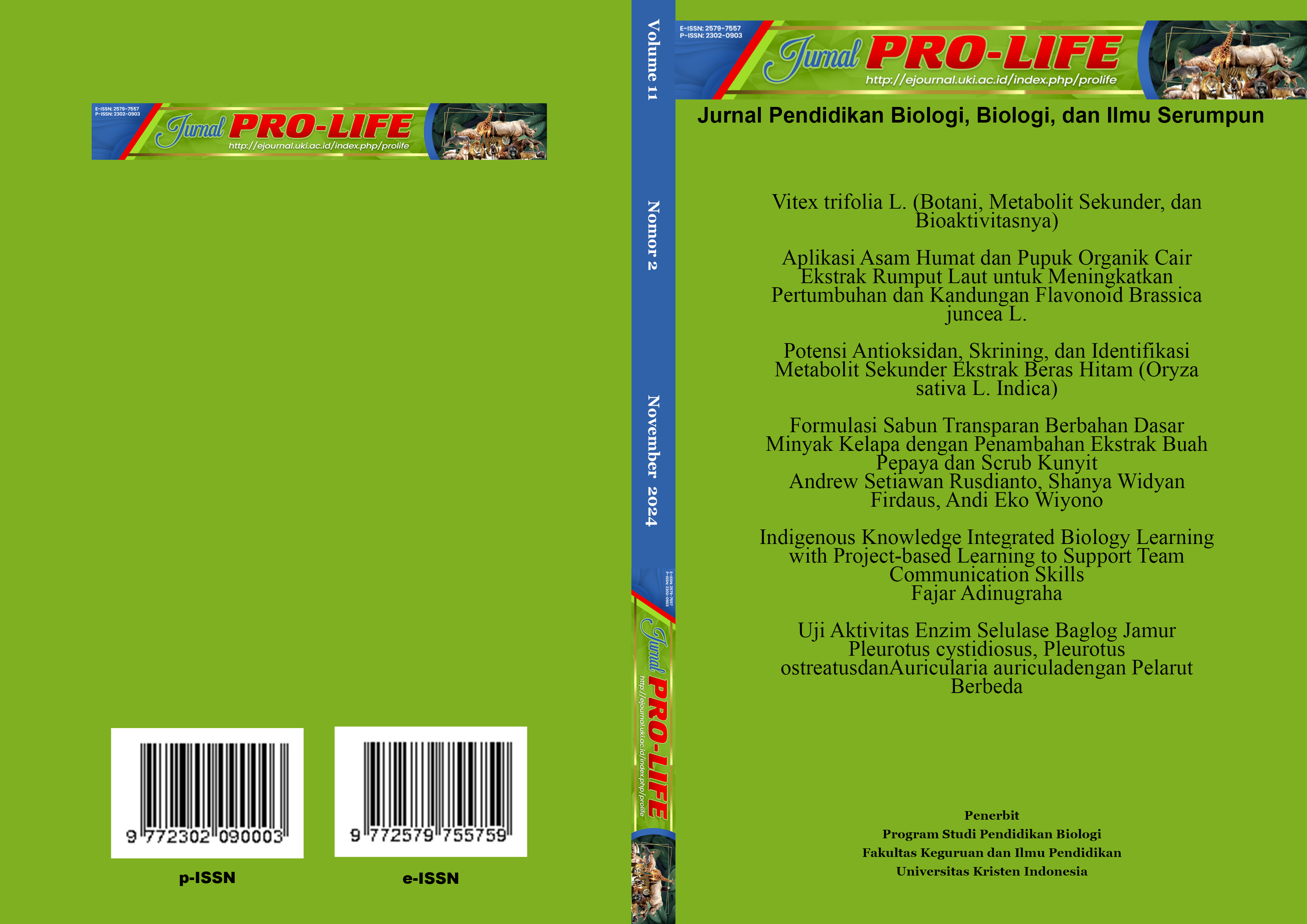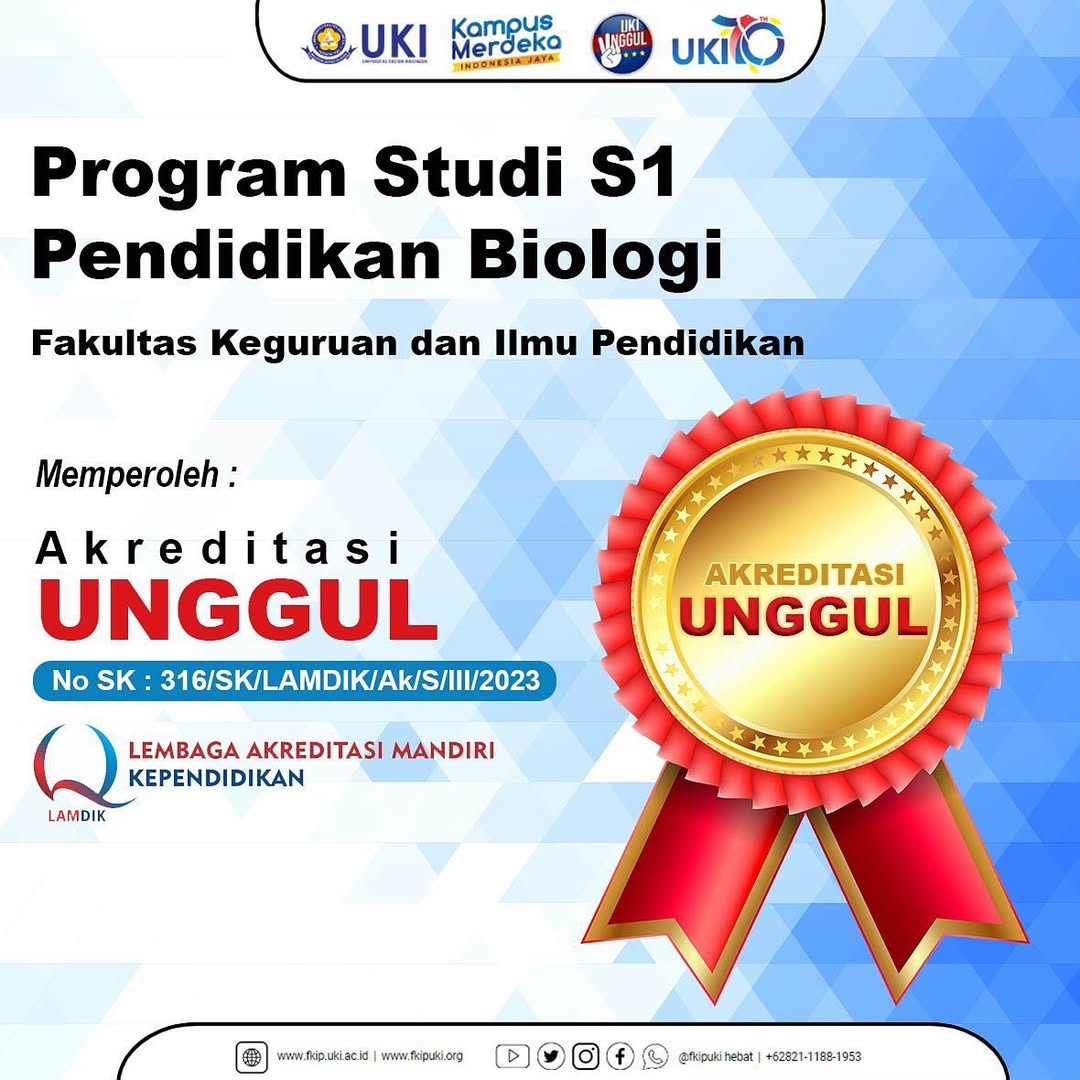Potensi Antioksidan, Skrining, dan Identifikasi Metabolit Sekunder Ekstrak Beras Hitam (Oryza sativa L. Indica)
DOI:
https://doi.org/10.33541/pro-life.v11i2.5655Keywords:
antioxidants, black rice, identification, secondary metabolites, screeningAbstract
Black rice (Oryza sativa L. indica) is a variety of pigmented rice that, apart from acting as a popular food ingredient, can also be used for health because it has active compounds that have the potential to act as antioxidants. The research carried out aimed to determine antioxidant potency, conduct secondary metabolite screening, and characterize the active compound content of black rice extract. It was macerated using a 96% pro-analysis (p.a.) ethanol solvent. Antioxidant potency was tested using the 2,2-diphenyl-1-picrylhydrazyl (DPPH) and ferric reducing antioxidant power (FRAP) methods, secondary metabolite screening using the Harbone method, and identification of active compounds using Gas Chromatography-Mass Spectrometry (GC-MS). It was found that black rice extract has potential as an antioxidant, using the DPPH method, the 50% Inhibition Concentration (IC50) value of black rice extract and vitamin C was 97.34 ppm and 2.64 ppm, respectively, but using the FRAP method, the IC50 values of black rice extract and vitamin C were 181.83 ppm and 7.84 ppm, respectively. Secondary metabolite screening detected that in black rice extract there were active compounds in the flavonoid and steroid groups, GC-MS identification results showed that the extract contained the most compound, hexadecanoic acid.
References
Alappat B., Alappat J. (2020). Anthocyanin Pigments: Beyond Aesthetics. Molecules, 25 (23), 5500. doi: 10.3390/molecules25235500
Alkadi, Hourieh. (2020). A Review on Free Radicals and Antioxidants. Infectious Disorders - Drug Targets (Formerly Current Drug Targets - Infectious Disorders), 20 (1), 16-26.
Amin A., Khairi N., Hendrarti W. (2022). Aktivitas Antioksidan Ekstrak Etanol Batang, Daun, dan Akar Kopasanda (Chromolaena odorata L.) dengan Metode FRAP (Ferric Reducing Antioxidant Power). Jurnal Sains dan Kesehatan, 4 (5), 473-480.
Arifa A.H., Elvira Syamsir E., Budijanto S. (2021). Karakterisasi fisikokimia beras hitam (Oryza sativa L.) dari Jawa Barat, Indonesia. Agritech, 41 (1), 15-24. DOI: http://doi.org/10.22146//agritech.53307
Baliyan S., Mukherjee R., Priyadarshini A., Vibhuti A., Gupta A., Pandey R.P., Chan C.M. (2022). Determination of antioxidants by DPPH radical scavenging activity and quantitative phytochemical analysis of Ficus religiosa. Molecules, 27, 1326.
Bharath B., Perinbam K., Devanesan S., AlSalhi M.S., Saravanan M. (2021). Evaluation of the anticancer potential of hexadecanoic acid from brown algae Turbinaria ornata on HT–29 colon cancer cells. Journal of Molecular Structure, 1235, 130229. https://doi.org/10.1016/j.molstruc.2021.130229
Daeli E., Ardiaria M., Candra A. (2020). Pengaruh pemberian nasi beras merah (Oryza nivara) dan nasi beras hitam (Oryza sativa L.Indica) terhadap perubahan kadar gula darah dan trigliserida tikus wistar (Rattus norvegicus) diabetes melitus tipe 2. Journal of Nutrition and Health, 6 (2), 42-56. https://doi.org/10.14710/jnh.6.2.2018.42-56
Farasat M., Khavari-Nejad R.A., Nabavi S.M., Namjooyan F. (2014). Antioxidant activity, total phenolics and flavonoid contents of some edible green seaweeds from Northern Coasts of the Persian Gulf. Iranian Journal of Pharmaceutical Research, 13(1),163-170.
Ganesan T., Subban M., Christopher Leslee D.B., Kuppannan S.B., Seedevi P. (2022). Structural characterization of n-hexadecanoic acid from the leaves of Ipomoea eriocarpa and its antioxidant and antibacterial activities. Biomass Conversion and Biorefinery. DOI:10.1007/s13399-022-03576-w
González P., Lozano P., Ros G., Solano F. (2023). Hyperglycemia and Oxidative Stress: An Integral, Updated and Critical Overview of Their Metabolic Interconnections. International Journal of Molecular Sciences, 24(11), 9352. doi: 10.3390/ijms24119352
Hernawan E., Meylani V. (2016). Analisis Karakteristik Fisikokimia Beras Putih, Beras Merah, dan Beras Hitam (Oryza sativa L., Oryza nivara dan Oryza sativa L. indica). Jurnal Kesehatan Bakti Tunas Husada, 15 (1), 79-91. DOI: http://dx.doi.org/10.36465/jkbth.v15i1.154
Hetharia G.E., Briliannita A., Astuti M., Marsono Y. (2020). Antioxidant extraction based on black rice (Oryza Sativa L. Indica) to prevent free radical. IOP Conference Series: Materials Science and Engineering, 823(1):012002. DOI:10.1088/1757-899X/823/1/012002
Hu Y., Zheng Z., Zhai D., Liang P., Wang Z., Jiang C., Guo Y., Chen H., Shen C., Wu Y., Liu L., Yi Y., Zhu H., Liu Q. (2024). A mini-review: Exploring the application prospects of the three major rules in the field of antioxidants. Journal of Molecular Structure, 1304, 137746. https://doi.org/10.1016/j.molstruc.2024.137746
Iqbal S., Sivaraj C., Gunasekaran K. (2017). Antioxidant and anticancer activity of methanol extract of seed of Datura stramonium L. Free Radicals Antioxidants, 7(2), 184-189. DOI: 10.5530/fra.2017.2.28
Jananie R.K., Priya V., Vijayalakshmi K. (2011). Determination of bioactive components of Cynodon dactylon by GC-MS analysis. New York Science Journal, 4,4, 16–20
Jun M., Fu H.Y., Hong J., Wang X., Yang CS., Ho C.T. (2006). Comparison of antioxidant activities of isoflavones from kudzu root (Pueraria lobateohwi). Journal of Food Science, 68(6), 2117 – 2122. DOI:10.1111/j.1365-2621.2003.tb07029.x
Kang M.Y., Kim J.H., Rico C.W., Nam S.H. (2011). A comparative study on the physicochemical characteristics of black rice varieties. International Journal of Food Properties, 14(6), 1241–1254. https://doi. org/10.1080/10942911003637350
Kaurinovic B., Vastag D. (2019). Flavonoids and phenolic acids as potential natural antioxidants. In E. Shalaby (Ed.), Antioxidants, 127-140. IntechOpen.
Khoo H.E., Azlan A, Tang S.T., Lim S.M. (2017). Anthocyanidins and anthocyanins: colored pigments as food, pharmaceutical ingredients, and the potential health benefits. Food & Nutrition Research, 61(1), 1361779. doi: 10.1080/16546628.2017.1361779
Kumar Deepak., Mehra, Kumar G., Koli G.K., Tiwari P.K., Kumar B. (2020). Pigmented rice: A miracle food for Modern-day world. Food and Scientific Reports, 1(10), 83-86.
Liu W., Feng Y., Yu S., Fan Z., Li X., Li J., Yin H. (2021). The flavonoid biosynthesis network in plants. International Journal of Molecular Sciences, 22(12824),1-18. https://doi.org/10.3390/ijms222312824
Mackon E., Guibeline Charlie Jeazet Dongho Epse Mackon G.C.J.D.E., Yao Y., Guo Y., Ma Y., Dai X., Jandan T.H., Liu P. (2021). recent insights into anthocyanin pigmentation, synthesis, trafficking, and regulatory mechanisms in rice (Oryza sativa L.) Caryopsis. Biomolecules, 11(3), 394. https://doi.org/10.3390/biom11030394
Mackon E., Guibeline Charlie Jeazet Dongho Epse Mackon G.C.J.D.E., Yao Y., Guo Y., Ma Y., Dai X., Jandan T.H., Liu P. (2023). Integrative HPLC profiling and transcriptome analysis revealed insights into anthocyanin accumulation and key genes at three developmental stages of black rice (Oryza sativa. L) caryopsis. Frontiers Plant Science, 14, 1211326. doi: 10.3389/fpls.2023.1211326
Maesaroh K., Kurnia D., Anshori J.A. (2018). Perbandingan metode uji aktivitas antioksidan DPPH, FRAP dan FIC terhadap asam askorbat, asam galat dan kuersetin. Chimica et Natura Acta, 6 (2), 93-100.
Nassour R., Ayash A., Al-Tameemi K. (2020). Anthocyanin pigments: Structure and biological importance. Journal of Chemical and Pharmaceutical Sciences, 13(4), 45-57.
Panda D.K., Jyotirmayee B., Mahalik G. (2022). Black rice: A review from its history to chemical makeup to health advantages, nutritional properties and dietary uses. Plant Sci. Today. 9 (SP3): 01–15. DOI: https://doi.org/10.14719/pst.1817
Pangerang F. (2021). Kandungan gizi dan aktivitas antioksidan beras merah dan beras hitam padi ladang lokal dari Kabupaten Bulungan, Provinsi Kalimantan Utara. Journal of Tropical AgriFood, 3(2), 93-100. DOI: http://dx.doi.org/10.35941/jtaf.3.2.2021.8475.93-100
Pornngarm L, Warathit S, Sariya M. (2019). “Anthocyanins and proanthocyanidins in natural pigmented rice and their bioactivities” in Phytochemicals in Human Health. Eds. Venketeshwer R., Dennis M., Leticia R. (Rijeka: IntechOpen;). DOI: 10.5772/intechopen.86962
Prasetyo B.F., Purwono R.M., Novarino A.V. (2021). Potensi antioksidan menggunakan metode DPPH ekstrak beras hitam (Oryza Sativa L Indica) dan penghambatan tirosinase. Jurnal Health Sains, 2 (9), 1132-1140.
Rahmawati F., Yang J.J., Bavelina I.R. (2022). Potensi Antijamur Ekstrak Andaliman (Zanthoxylum acanthopodium DC) terhadap Candida albicans. Prolife, 9(3), 610–62.
Seawan N., Vichit W., Thakam A., Thitipramote N., Chaiwut P., Pintathong P., Thitilertdech N. (2014). Antioxidant capacities, phenolic, anthocyanin and proanthocyanidin contents of pigmented rice extracts obtained by microwave-assisted method. Suranaree Journal of Science and Technology, 21(4), 301–306.
Sharma O.P., Bhat T.K. (2009). DPPH antioxidant assay revisited. Food Chemistry, 113(4), 1202-1205.
Tan P., Mayulu N., Kawengian S. (2016). Gambaran aktivitas dan stabilitas antioksidan ekstrak beras hitam (Oryza sativa L.) kultivar Enrekang Sulawesi Selatan. Jurnal e-Biomedik, 4 (1), 184-187.
Tena N., Martín J., Asuero A.G. (2020). State of the art of anthocyanins: antioxidant activity, sources, bioavailability, and therapeutic effect in human health. Antioxidants, 9(5), 451. doi: 10.3390/antiox9050451
Tyagi A., Shabbir U., Chen X., Chelliah R., Elahi F., Ham H.J., Oh D.H. (2022). Phytochemical profiling and cellular antioxidant efficacy of different rice varieties in colorectal adenocarcinoma cells exposed to oxidative stress. PLoS One, 2022, 7(6), e0269403. doi: 10.1371/journal.pone.0269403
Yuliantari N.W.A., Widarta I.W.R., Permana I.D.G.M. (2017). Pengaruh Suhu dan Waktu Ekstraksi terhadap Kandungan Flavonoid dan Aktivitas Antioksidan Daun Sirsak (Annona muricata L.) Menggunakan Ultrasonik. Scientific Journal of Food Technology, 4(1), 35-42.










.svg_.png)













